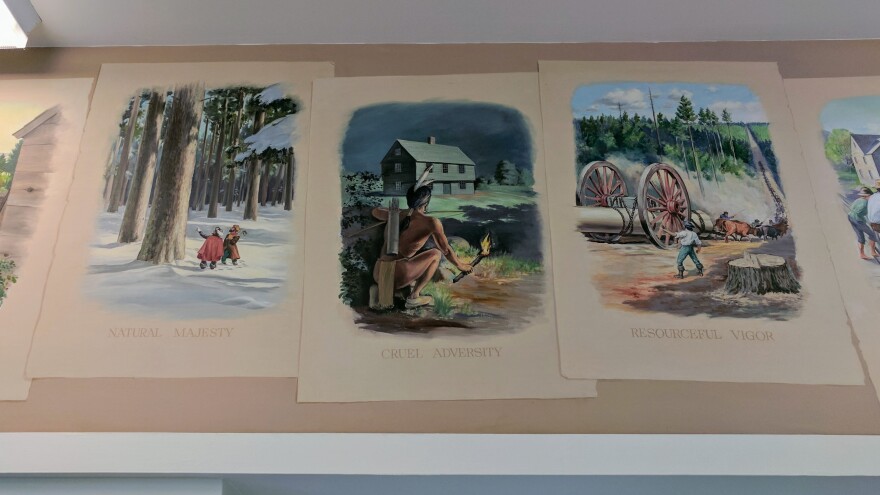At the center of the weekend's turmoil in Charlottesville is a statue of Confederate General Robert E. Lee.
While New Hampshire isn't seeing much debate over old confederate monuments, at a post office in Durham, a 1950's-era mural is raising questions about race and another uncomfortable chapter from our nation's history.
On a recent afternoon, Durham Town Administrator Todd Selig gave me a tour of the local post office.
Inside, it looks pretty much like every other post office -- boxes, stamps, greeting cards. There’s a long counter where postal workers help customers.
But Selig isn’t here to show me how the mail works.
"We’re here to see a mural that runs along the top half of the walls inside the post office."
"Wow you really can’t miss it."
“No. It almost looks like there are posters on the wall, but it’s actually painted on the wall.”
Sixteen of these painted-on posters make up the mural. Each one depicts a different chapter of Durham’s local history. All come with stirring titles.
“Relentless Progress” shows a train steaming through town. “Steadfast Faith” shows the Durham Community Church standing proudly.
For the most part the images are idyllic renderings of Durham’s beginnings painted by a local artist.
“It was dedicated in 1959 by the Women’s Club of Durham with all the best intentions. They didn’t set out to create a racist, discriminatory mural set,” Selig says.

But to some, that’s exactly what this is.
At issue is one image in the mural that shows a Native American. He’s crouched behind a bush looking out at a colonial cabin. He’s carrying a bow and arrows, and in one hand is a flaming torch. The image is titled, “Cruel Adversity.”
The painting is meant to represent the threat of Native American attacks on the town, including one in particular: the so-called Oyster River Massacre of 1694.
Kathleen Blake is a member of the New Hampshire Commission on Native American Affairs.
“It portrays the colonists as victims.”
She says the “Cruel Adversity” mural is derogatory and leaves out the many acts of aggression committed by European settlers.
“I mean, it could be the other way around. The cruel adversity could be the settlers in the garrison house rather than the native people who already lived here.”
Blake and the Commission on Native American Affairs want this panel of the mural removed or covered.
But Postal Service spokesperson Steve Doherty says that isn’t an option.
“The Postal Service policy is – this was a piece of artwork that was given to us as a gift back in the late 50s, and now as a curator of that art our job is to protect it and preserve it for future generations.”
The Postal Service has offered to install interpretative text near the mural to provide some of the missing historical context. The job of drafting that text fell to Jennifer Lynch, Postal Service Historian.
After some research at the Library of Congress and consultation with local experts, Lynch submitted a one page summary of historical context that could accompany the mural.
“I tried to show that it was complicated. And there wasn’t one side who was always the victim and one side always the aggressor; it wasn’t that way at all. It was a complicated situation with a lot of conflict.”
The text describes how an early period of peace descended into a cycle of attacks and reprisals, including the enslavement of hundreds of local Native Americans about 20 years before the Oyster River Massacre.
Back in present-day Durham, debate about the mural has made its way into town council meetings.
At a meeting last month, Councilor Firoze Katrak said the image was nothing residents today should be ashamed of.
“We should be taking pride in the Western civilization, we should be taking pride in our local history, and I don’t think white males have anything to apologize for,” Katrak said.
The Durham Town Council doesn’t have the power to do much about the mural, since it rests in a federal building. But they did voice their support for keeping the mural with interpretative text.
Some Durham residents though, are asking the council to come out against the mural. Diane Tregea is a former social studies teacher from Durham. She told councilors how the mural has affected her classroom and her family over the years.
“My daughter who is 30 years old recently shared with me how she feared Native Americans from standing in the post office. Many of my former students, some of them your children, have shared their fear that grew from that image.”
For now, the issue is on hold. The Native American Commission hasn’t decided if they are willing to settle for interpretive text. The Postal Service wants the Commission’s input before they would install any text.
The Women’s Club of Durham, which commissioned the mural, is no longer around. But a pamphlet they published in the 1980s suggests they wouldn’t mind all the attention the mural has been getting.
The pamphlet asks: “What better place than the post office to ensure its display for the entire community and visitors?”








